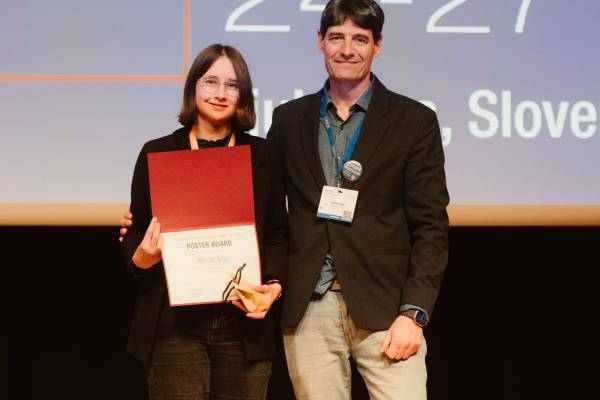Screen4Care Partner Won the Poster Prize at EMIM 2025!
The Screen4Care consortium is proud to share that our consortium partner, University Medical Center Göttingen (UMG), received the Poster Prize in the Gastrointestinal & Musculoskeletal category at the 20th European Molecular Imaging Meeting (EMIM 2025) in Bilbao, Spain! The award was presented by session chairs Dr. Hailong He (Munich, Germany) and Dr. James Joseph (Dundee, UK). You can find more information about the congress and other awardees here.
About UMG's Poster Presentation
Hannah Brüx presented UMG's feasibility of multispectral optoacoustic tomography (MSOT) for detecting structural muscle changes in inclusion body myositis (IBM). This research was conducted as part of her MD thesis under the supervision of Dr. med. Stefanie Meyer and PD Dr. med. Jana Zschüntzsch, with special thanks to co-author Alica Stobbe and all collaborators involved.
IBM is the most common idiopathic inflammatory myopathy in elderly patients, characterized by slow-progressing, asymmetrical muscle weakness, often leading to significant disability and impairment over time.
MSOT utilizes short-pulsed near-infrared laser light to non-invasively visualize tissue ultrastructure dependent on different absorption spectra of tissue chromophores. It enables us to unmix Hb, HbO2, Collagen and Lipid signal out of the single wavelength responses.
Study Overview
The UMG poster presented results from the statistical analysis of MSOT scans across three muscle regions in both arms and legs, highlighting both the methodology and scan reliability.
Key findings include:
Evaluation of the MSOT images: Using a 20 mm² ellipsoid region of interest (ROI) yielded highly reliable results, with intraclass correlation coefficients above 91% across all parameters while being a fast and easy applicable tool for analysis.
MSOT displayed muscle changes: IBM patients showed significantly increased lipid signals in all extremity muscles and leg muscles only and decreased collagen signals in extremity muscles, revealing that a consistent effect was observed in both extremities.
MSOT measurements correlated with functional assessments: Less impairment in the IBM-FRS as well as preserved muscle strength in Manual Muscle Testing correlated with higher collagen values. Again, the Lipid signal showed the opposite effect meaning lower muscle strength and accordingly lower Manual Muscle Testing (MMT) correlated with higher lipid values in Arms and Legs
Conclusion
This study represents, to our knowledge, the first clinical investigation of the application of MSOT in IBM patients. Not only was MSOT well tolerated by patients and healthy volunteers, but it also allowed UMG to show structural muscle changes that reflect the impairment of the IBM patients. These findings lay the groundwork for future studies using MSOT as a non-invasive biomarker for monitoring disease progression and activity in IBM patients. UMG is honored to have their work recognized and look forward to continuing research that bridges cutting-edge imaging with clinical neuromuscular diagnostics.

